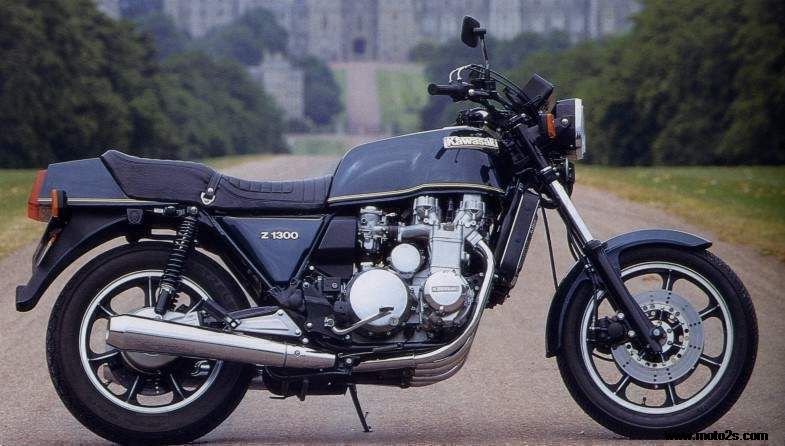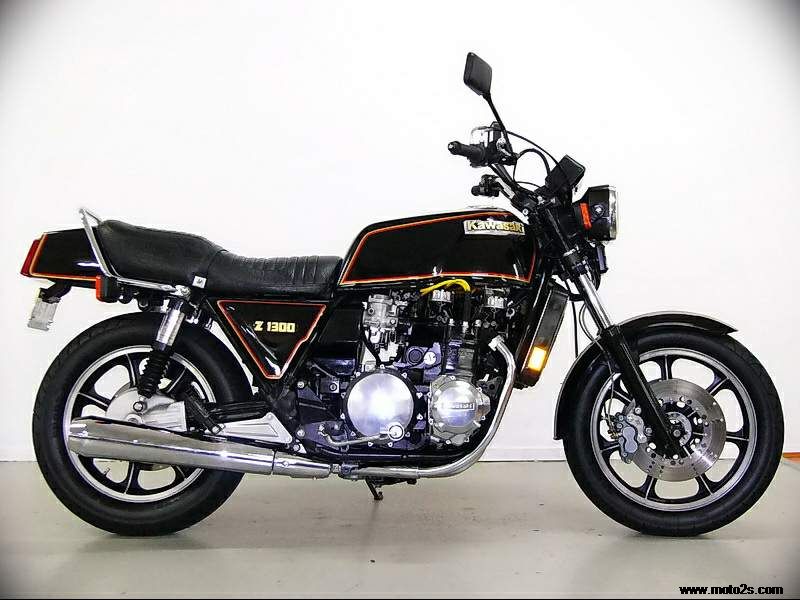Kawasaki Z 1300
The Z1300 was shown to the world at the Koln show in September 1978. The engine a liquid-cooled 1286cc DOHC two valve per each of the six cylinders sat in the bike which had a massive dry weight of 297kg. This was the "dreadnought" of touring bikes. In November 1978 the press were introduced to the Z1300, in Malta for the European press and Death Valley California for the American press. They were unanimous with praise for both styling and impressive performance of the ground breaking machine. The Z1300 was produced from 1978 until bowing out in 1989. In 1983 the Z1300 was given a digital fuel injection (D.F.I.) and was called the ZG1300, the system installed to improve fuel consumption gave a gain in power and torque. In march of 1983 the Voyager was launched, a fully dressed tourer:- it featured a fairing, panniers, top box, stepped seat, digital speedometer, radio/cassette deck and on board computer for trip and fuel calculations. The Voyager was a big hit with serious touring riders despite its higher price than its competitors. After its 12 year run the Z1300, Kawasaki's first liquid cooled six cylinder engined bike ceased production in 1989. 20,000 Z1300's and 4,500 Voyagers had been produced. Today as we stand testament for the Z1300 is still a popular choice for many bikers. In 1978 Honda and Benelli had a six, Kawasaki were to be different. The Z1300 was a six with water cooling and shaft drive:- the ultimate sports tourer. It was the heaviest at 297kg but the 120bhp was more than enough to power the bike to over 145mph. It soon found admirers all over the world. 1978. The Z1300 Prototype. The 1286cc motor was smooth and a masterpiece of design and easy to work on. The Z1300 was the "King of the road". 1979. The Z1300-A1 Starting frame number: KZT30A-000101 This the first model was only available in one colour, starlight blue with gold pin stripe. The Z1300 handled better than it should have and surprised many of the reviewers at the time. The brakes were poor and it had little ground clearance. But the Z1300 was in a class of its own. 1980. The Z1300-A2 Starting frame number: KZT30A-006201 The A2 was offered again in only one colour: ruby red. The A2 was an improvement over the A1, the sump was much bigger: A bid to counter act the crank problems the A1 had experienced. It was increased from a capacity of 4.5 litres of oil to 6. 1980. The KZ1300-B2 Touring Starting frame number: KZT30B-000001 This model was not released in the UK, being mainly a US model. It was basically a Z1300a with a fairing, top box and panniers. Again only one colour was offered: Royal dark red. The heaviest bike got even heavier. 1981. The Z1300-A3 Starting frame number: JKAKZAA15BA-011501 The A3 was available in two colours: Holy green and Ebony. A chrome grab rail was fitted and the outer engine cases and air filter covers were chromed. The electronic ignition was modified and gas rear shocks absorbers were fitted. The A3 was now also being built at the Lincoln factory in The USA. 1982. The Z1300-A4 Starting frame number: KZT30A-014101 1982 saw few differences in the Z1300, it was offered in two colours: Passion red or ebony. The CDI pickups were moved and the horn covers were changed. 1983. The Z1300-A5 Starting frame number: KZT30A-015901 The A5 had even few differences than previous models, the badges were changed but it was offered in the same colours. With bikes like the H1 500, the K2 750 and the Z900, Kawasaki earned a reputation for making the fastest and the most fearsome roadsters available. As the 1970s wore on, although the 900 grew into a 1000, the opposition began to catch up, overtake and zoom ahead with their own scorching road burners. Since 1973, however, Kawasaki Heavy Industries had been working on a new 'King' to wrest the laurels from its Oriental rivals. The brief was simple, the bike should be a 1200, have six cylinders and because of the company's expertise with such a layout, should have an in-line engine. Development continued slowly but surely on those lines until it was decided that, due to the bike's inevitable weight penalty, an even larger power unit was necessary. So when the new Kawasaki bike was announced to the press in late 1978, it was designated the Z1300 and featured a 1286cc engine. The width of a six-cylinder power unit mounted across the frame presents the biggest problem for designers because it limits banking angles and thus impedes rapid cornering. Such a unit also presents a large frontal area to the wind and makes manoeuvring in traffic somewhat perilous. Kawasaki's answer to the problem of making a compact six was to utilize water cooling. With water jackets around each cylinder, the gaps between can be narrower than if air is relied on for cooling. Although the Z1300 is rather large from crankcase end to crankcase end, the rest of the engine looks more the size of a big four. Of course, another advantage of water cooling is that it provides good sound insulation and this well-balanced six is notably quiet and smooth with few peers in this respect. Difficulty was found in accommodating the customary one carburetor for each cylinder, so the decision was made to use three twin-choke constant-vacuum carburettors. These were found to be more compact and fitted underneath the fuel tank without impeding the rider. The fuel mixture enters the combustion chambers by way of a single valve per cylinder, the company thinking that the expense of the four-valve-per-cylinder system was unjustifiable. Power is transmitted through a five-speed gearbox to a shaft drive, mounted on the right-hand side of the bike. With a weight of 640 lb to propel, and all of 120bhp to transmit to the 17in diameter rear wheel, it was obvious that a chain would just not be up to the job. Braking is taken care of by triple discs using the Kawasaki system of sintered metal pads, (two front, one rear). Surprisingly, once under way the bike is quite easy to ride and does not feel at all like the heavyweight it is. The engine is smooth and powerful and urges the machine forward at an even and very rapid rate.
There is no noticeable power band as such, just one turbine-like surge right up to the 8000 rpm mark. This corresponds to 135 mph in top gear, although a few more mph can be extracted if you risk running into the red sector of the rev-counter. Acceleration is certainly in the top bracket with a standing-start quarter-mile time which just reaches into the 'elevens'. There are one or two bikes which are faster but they are a fair bit lighter and not quite so comfortable. Another pleasant surprise is the machine's fuel consumption which is quite low and always on the good side of 40mpg. The instrumentation and switchgear of the bike are just what you would expect of a Japanese bike for the 1980s, and they are just about perfect for the job. The Z1300 has a large comfortable saddle which makes long-distance touring very comfortable indeed. It is hard to say just how big bikes will get before the trend to 'bigger and faster' stops, but critics should not dismiss the new Kawasaki as the ultimate unmanageable monster. It is in fact smooth, fast and easy to ride and an interesting step in the development of the powered cycle. Source : Super Bikes by Mike Winfield
|
1981-83年Kawasaki Z 1300
2013/7/30 9:57:00






